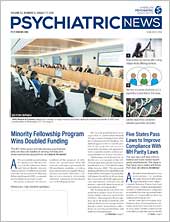In the wake of a series of mass shootings around the country, a resource document has been developed by APA’s Council on Psychiatry and Law to provide guidance for members on how risk-based gun removal laws may be used to prevent future tragedies. The document, which expresses the views of the authors, was approved in June by APA’s Joint Reference Committee.
“One of the strategies for gun violence prevention has been to develop risk-based gun removal laws,” said council Chair Debra Pinals, M.D., a clinical professor of psychiatry and director of the Program of Psychiatry, Law, and Ethics at the University of Michigan. “These laws offer families and others the opportunity to have a firearm removed from someone who may be at risk to themselves or others.”
Reena Kapoor, M.D., the lead author and an associate professor of psychiatry and associate program director of the forensic psychiatry fellowship at Yale School of Medicine, noted that as of late April, eight states had passed gun removal laws, and roughly 20 others were considering legislation.
Also referred to as “gun violence restraining orders,” or more loosely as “red flag laws,” risk-based gun removal laws are designed to address crisis situations. For example, a parent can ask police to remove firearms from the home if a teenager is threatening suicide. After a period of restriction, the individual can petition the court to have the firearms returned.
“Policies and practices vary significantly among states with gun removal laws regarding who can initiate the gun removal process, whether a warrant is required, what factors the court must consider before ordering firearm removal, what must be proven in court, how the firearms are restricted, and what process is used to restore the individual’s firearm access,” the authors wrote.
When the document was being drafted last year, four states—California, Connecticut, Indiana, and Washington—had enacted laws that allowed clinicians and family members to initiate gun removal regardless of the individual’s diagnosis or whether the individual had been diagnosed with a mental illness. The authors used these states as case examples.
The resource provides a “succinct” document for clinicians who may not be aware of how these laws operate in their respective states, Kapoor said. State psychiatry societies or individual psychiatrists can share it with legislators and policymakers to show them how these laws work, she added.
In 2014, APA published a resource document that addressed the complex relationship between firearms, mental illness, suicide, and violence. It highlighted the limitations of using registries such as the National Instant Criminal Background Check System to identify individuals at risk of harming themselves or others. The authors argued that background checks could unfairly stigmatize people with mental illness. As an alternative, the authors recommended risk-based firearm removal laws. The 2018 resource document summarizes research related to implementation of these laws.
“One of the things APA supported in the 2014 resource document is that there are risk factors for violence that are separate from mental illness, for example, anger or frustration,” Pinals said. While suicide risk is associated with firearms, she noted that numerous studies have shown that mental illness is not a risk factor for firearm violence against others.
“Most of the people whose guns were taken away in this manner have not received mental health treatment or been identified as having a major mental illness. They are people in crisis,” Kapoor said. “Family members, neighbors, and friends are the ones calling the police to say, ‘I am concerned about this person having a gun right now.’ Most of the time they are concerned because the person is a threat to themselves, not to others.” ■
“Resource Document on Risk-Based Gun Removal Laws” is posted at
http://apapsy.ch/Gun_Removal. Resource documents express the views of the authors and do not necessarily represent the views of APA’s officers, trustees, or other members.

